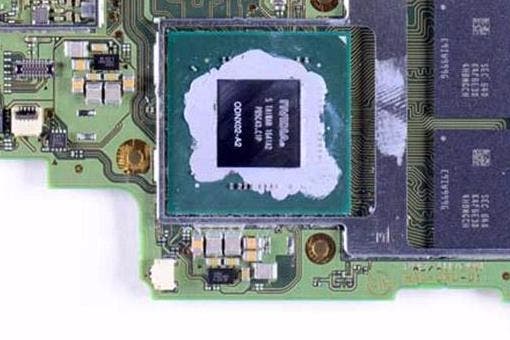Standard Tegra X1 'confirmed' as Switch's processor
Nintendo's claims of a custom chip come under scrutiny.
The final piece of the puzzle has seemingly fallen into place. Hardware analysis site Tech Insights updated its own Nintendo Switch teardown with die-shot photography of the new console's Tegra processor, mooted as a custom design by the platform holder. Only here's the thing - the configuration is a match for the standard Tegra X1, as seen in the Shield Android TV.
This is perhaps to be expected bearing in mind the increasing weight of evidence pointing towards an off-the-shelf design, as we outlined recently in our look at the first Switch teardown. The configuration of Switch's chip is visually a match for the processor found in the revised 2017 edition of Nvidia's own Shield Android TV, right down to the same assortment of surface-mounted capacitors surrounding the processor.
All of which raises a very pertinent question. If the physical configuration of the chip is a match for an established design, how has the processor been customised - if at all? All we have to go on is Nvidia's blog post on the subject, proclaiming that its inputs amount to "500 man-years of effort across ever facet of creating a new gaming platform". And yet the physical evidence points towards a match with an existing design, so what's the deal?
Well, to be fair, Nvidia's blog post talks about a lot more than just hardware - it covers system design, system software, APIs, game engines and peripherals. Maybe what they mean by a custom Tegra is the result of adapting an existing piece of technology to work as a dedicated console - and in that respect, clearly Switch is a significant achievement.
This week, we bought the new Tomb Raider 2013 port for Shield Android TV - a conversion carried out by Nvidia's own internal Lightspeed Studios (there's some media and analysis of it in the video below). On the face of it, the conversion work isn't bad at all, but it is rendering at 720p, and it moves with a truly off-putting jerkiness owing to a complete lack of frame-pacing. Our frame-rate measurements peg it at a constant 30fps, but the complete lack of consistency makes it look as though it's running a lot slower. This is almost certainly a by-product of the Tegra X1 operating within the constrained environments of the Android OS. Nintendo's own porting work with The Legend of Zelda: Breath of the Wild achieves much more at the same resolution, even running at reduced clocks in mobile mode. Alongside Shin'en Multimedia's brilliant Fast RMX, whatever 'secret sauce' Nvidia and Nintendo have cooked up here has produced a transformative effect on what is seemingly the same hardware.
It's the software that matters most and in this respect, Switch delivers - but there is still the sense that on a hardware level, we were being promised something different, something a little more cutting-edge. And this leads us on a story we'd like to share with you. Back when the Switch was officially announced and our 'Tegra in NX' story was validated, the Digital Foundry team sat down to record a videocast discussing the potential of the system based on the information Nintendo and Nvidia had presented to us.
Nvidia stated categorically that the Switch processor was based on the same architecture as the world's top-performing GeForce graphics cards. Well, that's the Pascal architecture powering the GTX 10 series, so by extension we made the logical conclusion that Switch was using a custom Tegra X2 - and yes, we spent a good portion of the videocast talking about that. Literally as the edit was completed, we learned from sources that Nintendo was still briefing developers with a very X1-looking spec - in timeframes where the firm would definitely be working with final silicon.
At the time of the reveal though, enough ambiguity about the spec was left in Nvidia and Nintendo's public proclamations (Pascal is essentially a 16nm version of Tegra X1's 20nm Maxwell GPU tech) that we took the decision to mothball our Tegra X2-orientated videocast until we could find out more. It just didn't make sense to release a video discussing a spec that didn't match with what Nintendo was telling developers. As the months rolled on, and new information emerged, we still didn't know to what extent the hardware had been customised, but we knew that Tegra X1 was the primary contributor to the base design. While fans continued to hope that the X1 leaks were based on incomplete dev kits with 'placeholder' processors, no updates to the Switch spec were passed on to developers - aside from near-final and final clock-speeds which only really made sense with a 20nm Tegra chip.
Specs and major PR releases these days are thoroughly vetted and run through legal channels before release, so we feel fairly sure that Nintendo and Nvidia wouldn't have talked about a custom spec without some kind of justification, but the Tech Insights X1 confirmation seems watertight at this point. And with that final piece of the puzzle dropping into place, we thought you might get a kick out of seeing that mothballed DF team discussion on the spec that never was. But going forward, could Tegra X2 ever make its way into a Nintendo handheld? Well, the firm has a history of revising its mobile consoles with more powerful hardware mid-way through the generation. Tegra X2 still has 256 CUDA cores and it still features a quad-core arrangement of ARM Cortex-A57s - but it runs faster, has double the memory bandwidth and two bonus Denver CPU cores. A couple of years down the road, maybe we'll see an X2-powered 'New Nintendo Switch'. In the meantime, we've asked Nvidia and Nintendo for comment on Tech Insight's findings and will update with any response.










